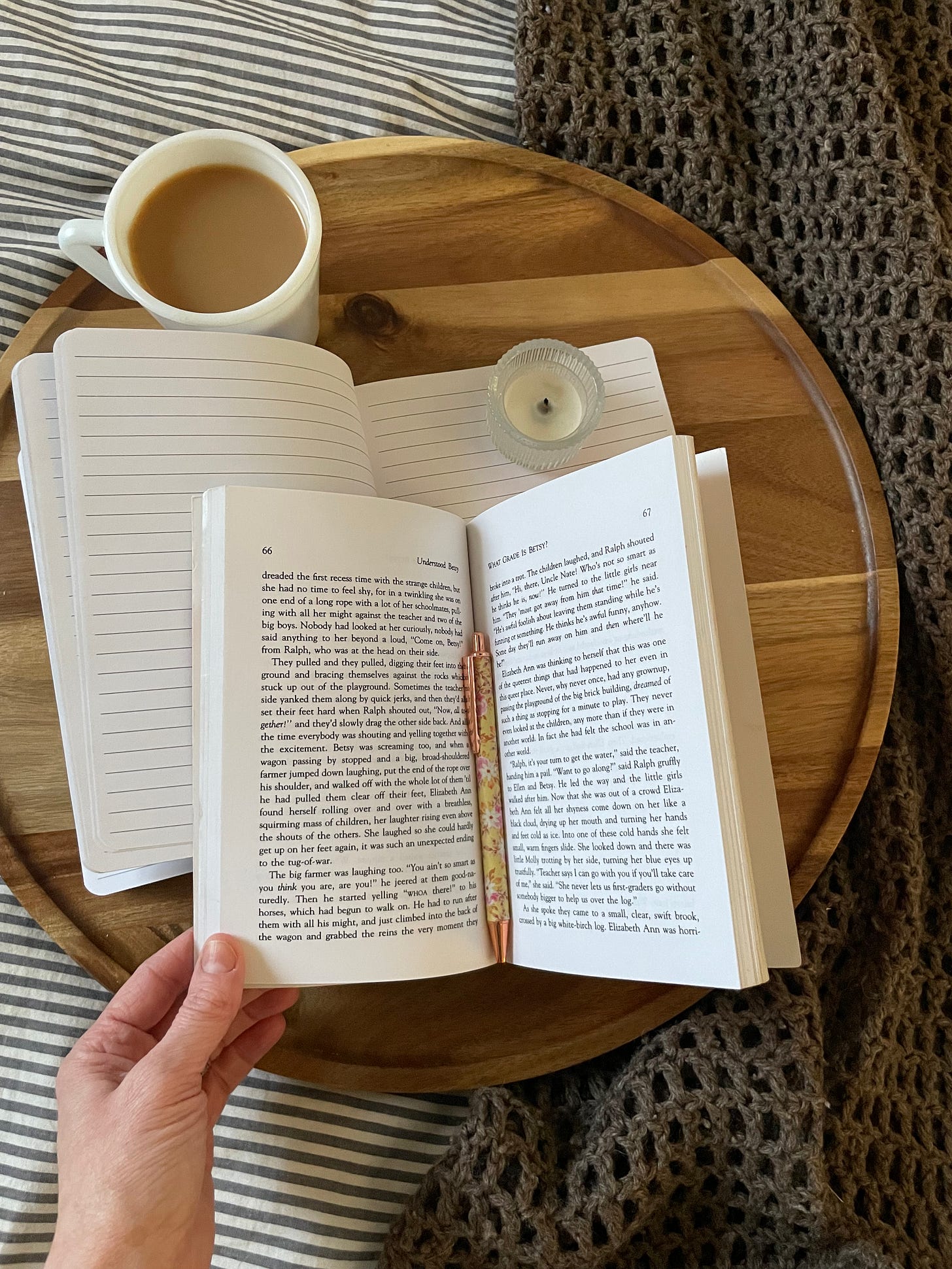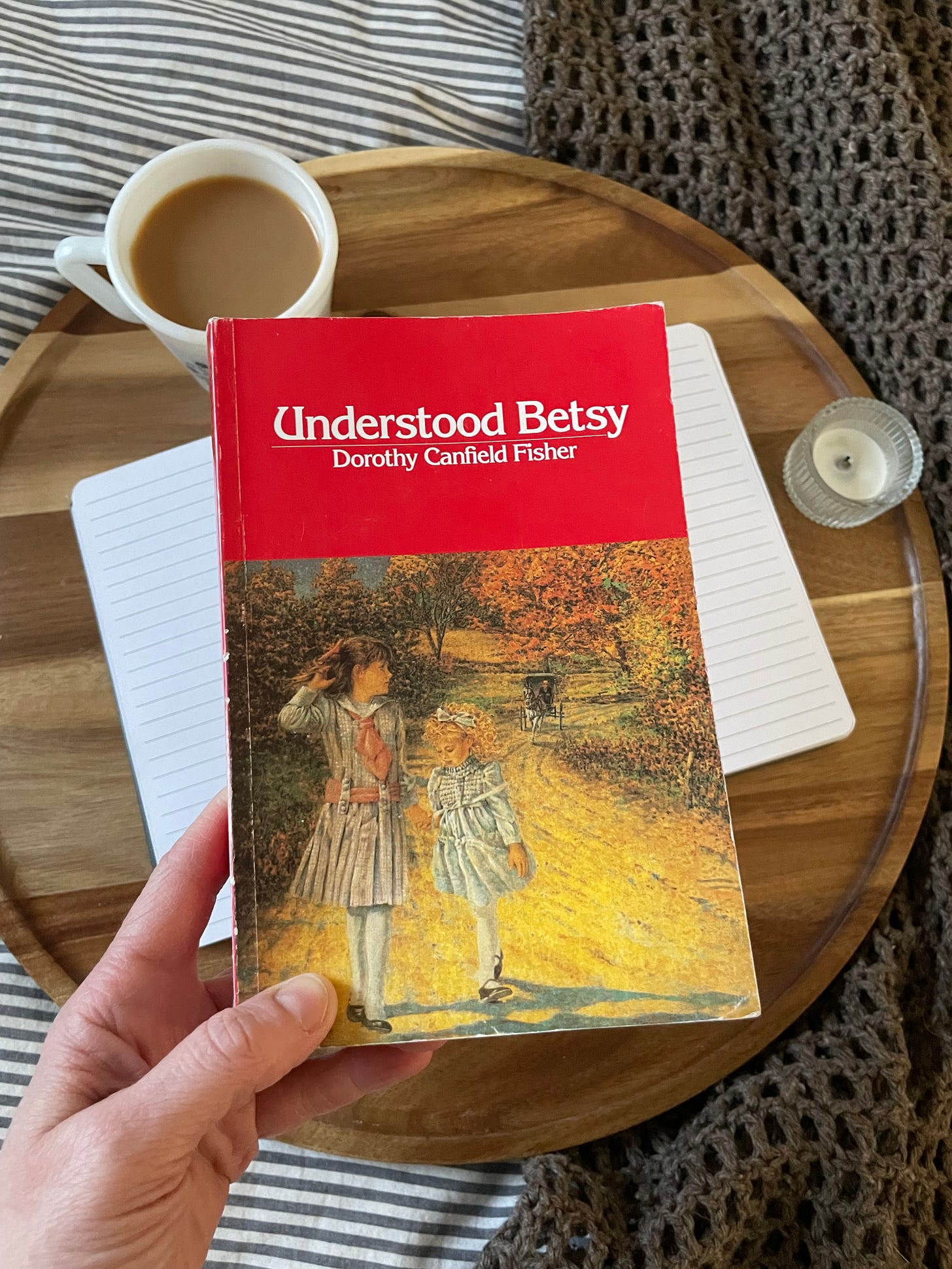Underestimated Understood Betsy
"A dim notion was growing in her mind that the fact that she had never done a thing was no proof that she couldn’t."
Let me read my literary analysis of Understood Betsy to you!
Click the “play button” above!
I underestimated Understood Betsy by Dorothy Canfield Fisher. It wasn’t until I heard that she had observed Montessori methods and had tried to communicate those ideas through the story of Understood Betsy that I gave it a try.
I still don’t think it’s really for kids but I say that kind of joking. I believe the book is for the adults that are around kids. After I read it myself, and found it delightful, I read it to my children and they loved it! They insist that it IS for kids! I liked reading it aloud because I got to give it all the voices of the characters and inflection in order to give some of the nuances meaning. Now I think that every adult who has any contact with children needs to read this book!
I love the writing style! I feel like I am sitting across the tea table from a kind soft lady that you just want to hug and she has just enough energy to tell me only the important parts of the story and there isn’t really time for anything else anyway because tea will be over and I’ll have to go home!
The first thing the author tells you is that Aunt Harriet has a cough. You don’t know who Aunt Harriet is, or who she is aunt to, or why a cough is a problem. Then she tells you that Elizabeth Ann is the heroine of the story and that she lives with Great-aunt Harriet and you don’t need to know anything more about that. Throughout the book, she talks directly to the reader and tells us when we don’t need to know any more information about something and that she (the author) will not be writing about that so don’t even bother asking.
But Elizabeth Ann, who is Betsy, lives with Great-aunt Harriet and Aunt Frances and everything about her life at Great-aunt Harriet’s and Aunt Frances’s house is very stiff and controlled, and like little grey squares all lined up in a row. Aunt Frances has devoted herself entirely to Elizabeth’s care and prides herself in being the only one who truly “understands” Elizabeth. “She shared in all Elizabeth Ann’s doings. In her thought, too. She felt she ought to share all the little girls’ thoughts, because she was determined that she would thoroughly understand Elizabeth Ann down to the bottom of her little mind.”
Everything changed with that fateful cough from Aunt Harriet. Elizabeth is rudely jerked from her square edged, perfectly shaded gray, predictable life, tossed into a carriage, then onto a train and sent off a thousand miles away with little thought from the adults for her “feelings”. She is sent to distant relatives who are only known to her as the “dreadful Putney’s.”
Up to this point, her life has been very ordered by sweet, kind, affectionate, loving, and very, very, very “conscientious” Aunt Frances. Elizabeth Ann despairs that she won’t even know how to breathe, let alone live without her precious Aunt Frances to take care of her. Now, Elizabeth has to learn to understand herself.

Betsy (as she is now called) spends alot of time comparing things at the Putney’s to things as they were with Aunt Frances. Uncle Henry, Aunt Abigail and Cousin Ann live in a cozy house, full of music and reading and hard work. Everyone helps out. Elizabeth Ann has a freedom here that she’s never experienced before and it sometimes horrifies her, sometimes delights her. She’s expected to do things that she’s never dreamed of doing on her own, all without fanfare or cheers but just as if it was natural that she should know how to do such-and-such.
“I never did,’ said the little girl, but in a less doubtful tone than she had ever used with that phrase so familiar to her. A dim notion was growing in her mind that the fact that she had never done a thing was no proof that she couldn’t.”
After figuring out something on her very own, we read “It is possible that what stirred inside her head at that moment was her brain, waking up. She was nine years old, and she was in the third-A grade at school, but that was the first time she had ever had a whole thought of her very own. At home, Aunt Frances had always known exactly what she was doing, and had helped her over the hard places before she even knew they were there; and at school her teachers had been carefully trained to think faster than the scholars. Somebody had always been explaining things to Elizabeth Ann so carefully that she had never found out a single thing for herself before. This was a very small discovery, but it was her own.”
The story continues as Betsy herself opens up like a beautiful peony flower that started off hard and tight and softens into loveliness and sweet smells and delight in the beautiful world.
At the end, Aunt Frances returns and Betsy has to make a unique decision, and suddenly, she realizes that she in fact, “understands Aunt Frances”.
In reality, Aunt Frances didn’t understand Elizabeth Ann. She almost molded Elizabeth Ann into her own way of thinking, into her own fears. At Aunt Abigails, she learns to love, to be daring, to have compassion and give up self-glory for the sake of someone else. Aunt Frances had always thought that by careful control, she could help Elizabeth Ann be strong and capable, but exactly the opposite had happened. Elizabeth Ann had relied on Aunt Frances to sturdy her up, to take care of everything. In fact, she believed herself incapable of figuring anything out on her own. She was fearful of everything. Aunt Abigail on the other hand, let her bend in the wind, let her experience things and make decisions that were appropriate for her age. Lets her fail. She becomes strong and capable, compassionate, even motherly to a little girl in need. These are the themes that I believe the author is using a story to teach. Children are very capable, but like little plants that need some protection but also need to sit out in the sun and breeze in order to build up their strength and be ready to go out when they are bigger. And that’s why I loved this book.
By the way, I intensely dislike the cover, and it is the main reason that I took so long to read it. Some time, I’m going to do a study about lousy book covers and how they keep us out of good books, and may be some publisher will take note!
I hope you enjoy it!
Comment if you’ve read it or another book you like!






That was a terrific analysis and review of UNDERSTOOD BETSY! Thank you! I really enjoyed it. Do another! Do another!